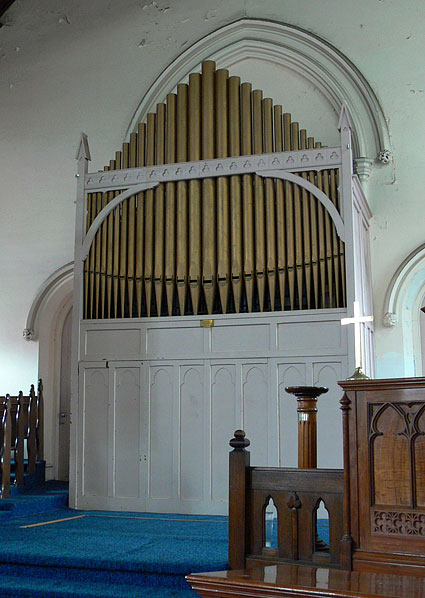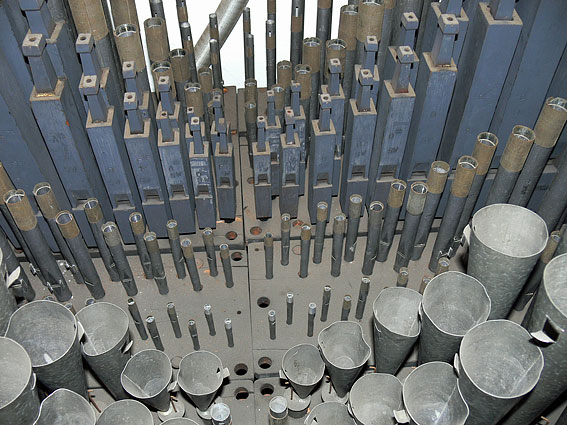The Current Instruments
The instruments at St Mary’s and All Saints are reaching the end of their working lives, each for different reasons. Work will be needed to keep each instrument in service.
St Mary’s has an electronic organ which is more than thirty years old – well above the average working life expectancy for electronic instruments of the period. It has always been the case that electronic devices have an inherent element of inbuilt obsolescence, be it in the form of components that go out of manufacture or simply the standard of performance over time. Very often an electronic instrument simply ceases functioning and cannot be repaired, or can only be put back into service at considerable expense.
The organ at All Saints has been displaying signs of mechanical collapse for some time now. Many of the symptoms will have been noticed by worshipers in this centre: pipes sounding when they shouldn’t (ciphering), stops and couplers failing to engage or disengage, wind leaks, and notes that don’t work, leading to chords sounding hollow in some keys. While many of these faults can be fixed, they will not remain fixed for very long without comprehensive work on the key and stop actions.
A further consideration is the purpose of having organs at St Mary’s and All Saints. For many people, the essence of Anglican worship is the quality of the music, whether it is sung by a choir or wholly congregational. This is an important part of our tradition for which the organ is indispensible.
While the organs at St Mary’s and All Saints are adequate for primary functions, such as leading hymns, there is little musical interest about either organ for the performance of organ or choral repertoire. The current instruments are highly restricted, which limits the potential for expansion of music in the liturgy, or for holding concerts and other musical events to increase the parish’s presence in the local community.
Repair or Replace?
Why can’t we just repair the instruments we’ve got?
Is replacement really necessary?
Repairs are certainly possible, but this simply leaves the existing problems in place at considerable expense. The ultimate answer to this question is whether the money spent on repairing existing instruments represents good value, and whether the outcome is of sufficiently high quality.
The electronic organ at St Mary’s has given very good service over its lifetime. Replacing it with an instrument of similar quality would be a very expensive exercise, and would create similar problems for the parish 30 years down the track when the limitations of present-day technology meet once more with long service. Would this be a good investment if given the choice to replace it with a well-built pipe organ, where there is no problem with inbuilt obsolescence?
The organ at All Saints has had significant work undertaken in the last 25 years, yet numerous faults have appeared (or re-appeared) in the meantime. Can it really be said that the investment in that repair work was money well-spent if the instrument has deteriorated, and what does it say about the quality of the work performed at the time? What’s to say that repeating the exercise of repair would do little more than defer serious problems into the future?
Two organs have been gifted to the parish, as possible replacements for the present instruments.
The first is a single-manual (one keyboard) mechanical action instrument, which is presently located in Launceston. It was originally placed in a Uniting Church in northern Tasmania, and is thought to have been built by a Bevington & Son, one of the most prominent London organ builders in the mid-nineteenth century. The instrument has been in storage at Scots Oakburn College in Launceston for some years. The parish was offered the instrument after responding to an advertisement in the Society of Organists newsletter.
The second organ has been donated by Brunswick Baptist Church. This is a large two-manual instrument, which has been left redundant after the congregation decided to renovate their sanctuary in line with changes to their pattern of worship. The instrument has not been in regular use for some considerable time, and the congregation decided to gift it to the Parish of Jika Jika because they wished it to go to a new home where it will be used for weekly worship. The commencement of the parish youth choir, which opens the possibility of the parish encouraging a new generation of organists, helped to seal their decision.
This instrument was built in 1880 by Gray & Davison, one of the most important organ building firms in London prior to 1914. It was originally placed in Old St Pancras Church, one of the oldest sites of Christian worship in London, before being brought to Australia sometime in the 1920s, where it was placed in Brunswick Baptist Church in 1929. The original tonal scheme is intact, in spite of two major rebuilds, which gives it high heritage value. This is one of a very few examples of an organ by Gray & Davison from the period in Australia, and would represent an important addition to the fabric of All Saints. More information about this instrument can be found on the website of the Organ Historical Trust of Australia.
The Money Question
The parish vestry has agreed to the project proceeding under the condition that the money will not come from existing capital.
This means that a large amount of funds will need to be raised from beyond the immediate parish community. There are many options to allow this: for example, cultural grants from the local council and state government, the diocesan cultural organization, private philanthropic trusts and various public-sector grants committees. The parish is setting up a tax-deductable fund to increase the potential for receiving grants, and to encourage donations from private individuals and parishioners.
The two instruments require different amounts of work to put them into service, which affects how much it will cost. It will only be possible to say how much the work will cost once the parish receives quotes from organ builders.
The important thing to remember is that the cost of replacing the existing instruments is either comparable with, or cheaper than, repairs.
The smaller instrument will be arriving in Melbourne sometime between mid-November 2010 and February 2011. Depending on how it has been handled in shipping, it should be possible to install it immediately. There may be some small repair work to undertake in the process of installation.
The organ at Brunswick Baptist Church must be removed before the end of January 2011. This means that a contract for refurbishment and transfer of the instrument to All Saints needs to be in place by the end of 2010. It may be necessary to store the instrument before work can proceed. The time between the organ leaving Brunswick and arriving in Preston ultimately depends on fundraising.





No comments:
Post a Comment